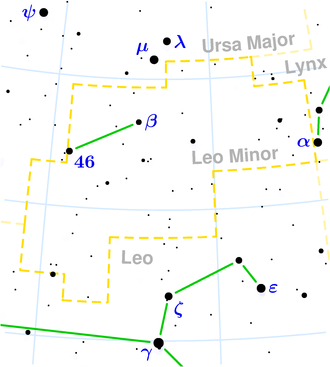NGC 3106
| Galaxy NGC 3106 |
|
|---|---|
![NGC 3106 with LEDA 1936548 (lo) ECO 1257 (r.) [1]](https://upload.wikimedia.org/wikipedia/commons/thumb/2/29/NGC3106_-_SDSS_DR14.jpg/300px-NGC3106_-_SDSS_DR14.jpg)
|
|
| NGC 3106 with LEDA 1936548 (lo) ECO 1257 (r.) | |
| AladinLite | |
| Constellation | Little lion |
|
Position equinox : J2000.0 , epoch : J2000.0 |
|
| Right ascension | 10 h 04 m 05.2 s |
| declination | + 31 ° 11 ′ 08 ″ |
| Appearance | |
| Morphological type | S0 / LINER |
| Brightness (visual) | 12.3 mag |
| Brightness (B-band) | 13.3 mag |
| Angular expansion | 1.8 ′ × 1.8 ′ |
| Surface brightness | 13.5 mag / arcmin² |
| Physical data | |
| Affiliation | isolated |
| Redshift | 0.020698 ± 0.000093 |
| Radial velocity | 6205 ± 28 km / s |
|
Stroke distance v rad / H 0 |
(276 ± 19) · 10 6 ly (84.5 ± 5.9) Mpc |
| history | |
| discovery | William Herschel |
| Discovery date | March 13, 1785 |
| Catalog names | |
| NGC 3106 • UGC 5419 • PGC 29196 • CGCG 153-013 • MCG + 05-24-009 • IRAS F10012 + 3125 • 2MASX J10040526 + 3111071 • GC 2001 • H II 320 • h 666 • NSA 85701 • LDCE 705 NED001 | |
NGC 3106 is a lenticular galaxy with an active nucleus of the Hubble type S0 in the constellation Little Leo in the northern sky . It is around 276 million light years away from the Milky Way and has a diameter of around 145,000 light years .
In the same area of the sky are u. a. the galaxies NGC 3116 and NGC 3126 .
The supernovae SN 1983J ( Type Ia ) and SN 2009gt were observed here.
The object was discovered by Wilhelm Herschel on March 13, 1785 .
Web links
Commons : NGC 3106 - collection of images, videos, and audio files
